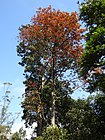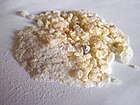Note: This is a project under development. The articles on this wiki are just being initiated and broadly incomplete. You can Help creating new pages.
Canarium strictum - Mandadhupa
Mandadhupa, is a tall evergreen tree with pinnate leaves and can found growing along rivers and streams in the western ghats. New leaves emerge bright red. Resin from the stem is harvested.
Uses
Parts Used
Chemical Composition
Common names
| Language | Common name |
|---|---|
| Kannada | haale maddu, haalu maddi, kari dhoopa, mandadhupa, raala dhoopa |
| Hindi | kala dammar |
| Malayalam | karunkungiliam, kunthirikkapayin |
| Tamil | kakanemi, karukunkiliyam, kungiliam, kunturukkam |
| Telugu | nalla-rojan, nallarojanamu, nallarojen |
| Marathi | NA |
| Gujarathi | NA |
| Punjabi | NA |
| Kashmiri | NA |
| Sanskrit | mandadhupa, raladhupa |
| English |
Properties
Reference: Dravya - Substance, Rasa - Taste, Guna - Qualities, Veerya - Potency, Vipaka - Post-digesion effect, Karma - Pharmacological activity, Prabhava - Therepeutics.
Dravya
Rasa
Tikta (Bitter), Katu (Pungent), Kashaya (Astringent)
Guna
Laghu (Light)
Veerya
Ushna (Hot)
Vipaka
Karma
Kapha, Vata
Prabhava
Habit
Identification
Leaf
| Kind | Shape | Feature |
|---|---|---|
| Pinnate | alternate | Leaves imparipinnate, alternate; stipules obscure; leaflets 7-11, opposite, 7-16 x 3.5-7 cm, ovate, ovate-lanceolate, oblong-ovate or elliptic-ovate, base acute or oblique, apex acuminate, margin serrulate or crenulate, glabrous above, rusty tomentose beneath, coriaceous; petioule 3-10 mm long, stout, tomentose; rachis 22-36 cm long, stout, tomentose, swollen at base; lateral nerves 10-20 pairs, parallel, prominent; intercostae scalariform, prominent. |
Flower
| Type | Size | Color and composition | Stamen | More information |
|---|---|---|---|---|
| Polygamous | axillary panicles | Pale yellow | male flowers; pedicels short; calyx tube campanulate, pubescent without, 5 mm; lobes 3, 1 mm; petals 3, oblong, concave, apiculate; disc annular, to 6 lobed, apically pilose; staminal tube to 3 mm; stamens 6, free from the disc; filaments 1 to 2 mm; anthers oblong, subequal; pistillode short; bisexual flowers: pedicles elongate; calyx urceolate, 4 mm, pubescent; lobes 3, valvate; petals 3, white, 1 cm long, oblong, pubescent without; disc obscurely lobed, pilose above; staminal tube to 3 mm; filaments 0.5 mm; anthers subequal; ovary superior, to 3.5 mm, 3-celled, ovules 1 in each cell; style 1, stout; stigma capitate, 2-3 lobed. |
Fruit
| Type | Size | Mass | Appearance | Seeds | More information |
|---|---|---|---|---|---|
| A drupe | 3.5 x 1.5 cm | ellipsoid, dark blue, 1-3-celled; seeds 1-3. | {{{6}}} |
Other features
List of Ayurvedic medicine in which the herb is used
Where to get the saplings
Mode of Propagation
How to plant/cultivate
Season to grow
Soil type
Propagation
Commonly seen growing in areas
Photo Gallery
References
External Links
Categories:
- Ayurvedic Herbs known to be helpful to treat Psoriasis
- Ayurvedic Herbs known to be helpful to treat Skin diseases
- Ayurvedic Herbs known to be helpful to treat Arthritis
- Ayurvedic Herbs known to be helpful to treat fever
- Ayurvedic Herbs known to be helpful to treat Epilepsy
- Ayurvedic Herbs known to be helpful to treat Asthma
- Herbs with Resin used in medicine
- Herbs with common name in Kannada
- Herbs with common name in Hindi
- Herbs with common name in Malayalam
- Herbs with common name in Tamil
- Herbs with common name in Telugu
- Herbs with common name in Sanskrit
- Habit - tree
- Index of Plants which can be propagated by Seeds
- Herbs that are commonly seen in the region of Tropical area
- Herbs that are commonly seen in the region of Evergreen forest
- Herbs
- Plants of western ghats
- Tree






